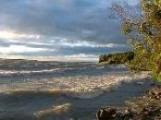Carp die-off in Lake Simcoe may last a while
Carp die-off in Lake Simcoe may last a while;
During the Canada Day celebrations, we received many questions at our booth about the local carp deaths. This is a major concern to residents as the remains
are visible, often washing up on shores and public beaches. Due to the interest we decided to cover this as our first article on invasive species.
Carp is an exotic invasive species. This means they are not originally from this area, but were brought here by early settlers. They originally entered Lake Simcoe in the late 1800s when flooding caused the small millponds where they lived to overflow into the Holland River at the south end of the lake. Carp are generally local to the eastern parts of Asia and to Russia, although many people believe they are native to
North America. They compete with native fish for resources, can
carry diseases, and disturb the natural
state of water bodies (such as upsetting sediment which can settle on eggs from native species or slow plant growth).
Last year, a similar problem with carp die-offs occurred in the Kawarthas, particularly in Lake Scugog. The peak for the die-off lasted approximately two to three weeks, but it may take longer to exit the local waterways because of the size of our lakes.
Last year, koi herpes virus was found in some of the carp tested and, although this may also be found in local carp, lab results have not yet been confirmed. It is always very difficult to determine the original source or how long the virus has been around before it began affecting the carp.
However, there are a number of possible pathways of diseases. One includes the aquarium trade. It is extremely important that you never release any aquarium water, plants or fish into the environment as any of them could carry diseases that would adversely affect resident aquatic life. It is illegal to release bait bucket water into any body of water.
Other cases of species dying, like the brown bullhead, have been reported, but the vast majority are carp. The hotline for reporting cases of deceased fish is 1-866-929- 0994. They are especially interested in hearing about sick fish that could be collected for further testing by the lab. Water quality concerns should be addressed to the local health unit at 721-7520 or 1-877-721-7520.
Keep in mind that landowners are responsible for the cleanup of private shorelines. Municipalities are responsible for public beaches and shores, whereas the Ministry of Natural Resources is responsible for provincial parks. There is no assigned responsibility for open waters, and fish typically wash up on shore before they are collected.
Advertisement
You should never touch a dead animal with your bare hands. When cleaning up deceased fish, wear gloves, disinfect tools, and wash your hands.
For disposal, if numbers are low, you can bury them. Alternatively, or for larger quantities, double bag the remains and either set them out for garbage pick-up or take them directly to the waste facility. Do not throw dead fish back into the water or allow them to rot on shore.
We hope to write a follow-up article later in the summer when more information becomes available. Please check back for more information and, in the meantime, enjoy our other articles on invasive species and species at risk.
Visit us at the Kids For Turtles office or call us at 325-5386 for more information or Ontario Federation of Anglers and Hunters handouts on invasive species.




0 Comments:
Post a Comment
<< Home